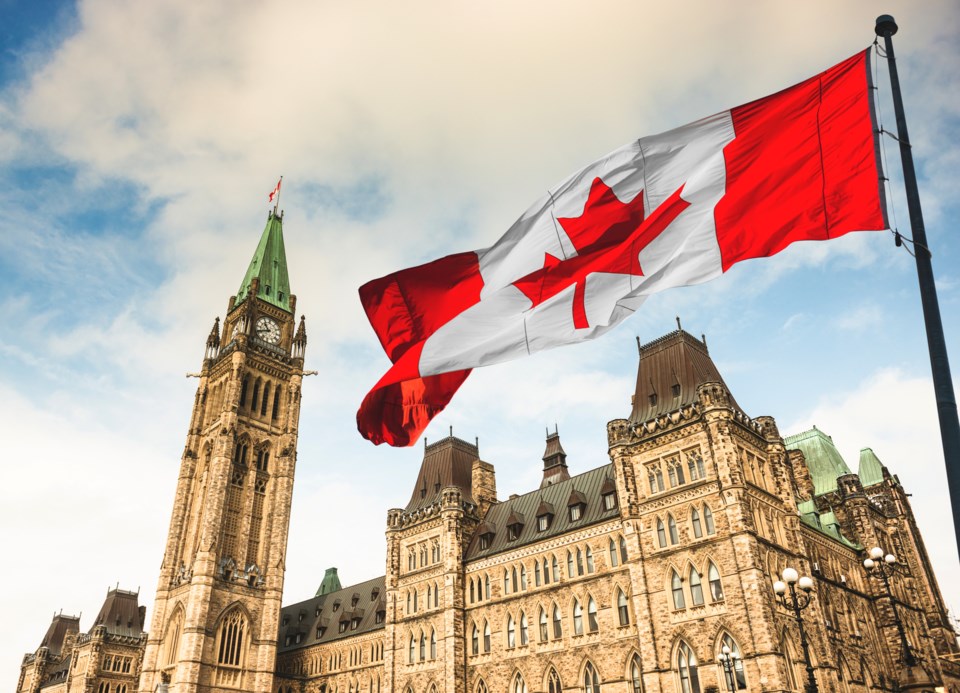With just a week before most Canadians cast their ballot in the 2025 federal election, the two-party race that developed immediately after the prime minister’s visit to the governor general remains in place. Across the country, 43 per cent of decided voters(down one point since early April) would vote for the Liberal Party, while 38 per cent would back the Conservative party (up two points).
Four other parties remain in single digits: the NDP (eight per cent, unchanged), the Bloc Québécois (six per cent, up one point), the Green Party (two per cent, down one point) and the People’s Party (one per cent, down one point).
For Official Opposition supporters looking for momentum, there are some positive signs. The retention rate—the proportion of 2021 Conservative voters who will stay with the party in 2025—stands at 88 per cent. While 14 per cent of Liberal voters in 2021 are now backing the Conservatives, a lower proportion of Tory supporters in the last federal election (nine per cent) are backing the Grits.
The Conservatives have jumped to 65 per cent in Alberta but trail the Liberals in Ontario by six points (40 per cent to 46 per cent) and in British Columbia by three (41 per cent to 44 per cent). The race is now closer, but with the Liberals in first place, among Canadians aged 35-54 (43 per cent to 40 per cent) and aged 18-34 (39 per cent to 36 per cent). The biggest hindrance for the party led by Pierre Poilievre is its inability to break through with voters aged 55 and over, where the Liberals are ahead by 10 points (48 per cent to 38 per cent). This might explain the rationale for the “driving range” campaign ad that launched this past weekend.
The gender gap also remains a problem for Poilievre. His party is statistically tied with the Liberals among men (42 per cent to 41 per cent) but has a 10-point deficit to clear among women (35 per cent to 45 per cent).
The Liberals continue to connect in the places they need to. Aside from what would be a historic finish for the party in British Columbia, the governing party is getting two votes for every vote that goes to the Bloc Québécois in Quebec (46 per cent to 23 per cent, with the Conservatives at 21 per cent). Four in five voters in who backed Justin Trudeau’s Liberals in 2021 (80 per cent) are staying with Mark Carney in 2025.
For the New Democrats, the situation is dire. As the campaign rolls on, their retention rate is slipping dramatically. Only 39 per cent of those who supported the NDP in 2021 are going to vote for the party in 2025, with 40 per cent saying that they intend to back the Liberals this year. Also, certainty of vote—decided voters who say they will not change their mind before casting their ballot—is lower for the NDP (79 per cent) than for the Liberals or the Conservatives (86 per cent each).
The approval rating for Carney is still markedly higher (59 per cent, up one point) than the numbers posted by Poilievre (47 per cent, up three points), NDP Leader Jagmeet Singh (44 per cent, up four points), Bloc Leader Yves-François Blanchet (28 per cent, up three points), Greens co-leader Jonathan Pedneault (27 per cent, up two points) and People’s Party Leader Maxime Bernier (21 per cent, down one point). Carney also remains ahead on the “Best Prime Minister” question with 45 per cent (up two points), followed by Poilievre (35 per cent, up six points), and also outranks Poilievre as a person people would be comfortable with on economic matters (59 per cent to 50 per cent).
Our question about leader character traits tells the story of the current success of the Liberal campaign. Out of the top five words that Canadians associate with Carney, four are positive and show a significant increase from the numbers posted by Trudeau in April 2023: intelligent (48 per cent, up 13 points), strong (35 per cent, up 16 points), efficient (33 per cent, up 16 points), honest (27 per cent, up eight points) and dishonest (25 per cent, down 11 points).
For Poilievre, the needle has barely moved since February, and only two of the top five words Canadians associate with him are positive: arrogant (39 per cent, down one point), intelligent (33 per cent, unchanged), strong (30 per cent, down two points), dishonest (27 per cent, up one point) and out of touch (24 per cent, up one point).
Canada-U.S. Relations remains the most important issue facing the country (28 per cent, down three points), followed by housing, homelessness and poverty (20 per cent, up two points), the economy and jobs (19 per cent, unchanged) and health care (nine per cent, down two points). On each one of these issues, Carney is preferred to Poilievre, with a 14-point advantage on managing the Americans (48 per cent to 34 per cent).
We are just over a week away from knowing who will form the next federal government. In any other election, a five-point increase in vote totals that propels the Conservatives to 38 per cent would herald a change of government. The collapse of the NDP to the direct benefit of the Liberals has put Carney in a position that seemed implausible at the start of the year.
Mario Canseco is president of Research Co.
Results are based on an online survey conducted on April 19 and April 20, 2025, among a representative sample of 1,006 likely voters in Canada, including 965 decided voters in the 2025 federal election. The data has been statistically weighted according to Canadian census figures for age, gender and region in Canada. The margin of error—which measures sample variability—is +/- 3.1 percentage points for likely voters and +/- 3.2 percentage points for decided voters, 19 times out of 20.


